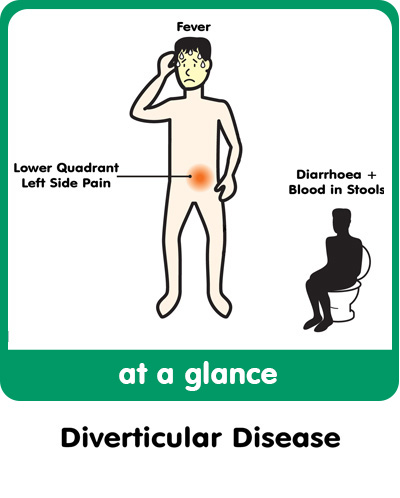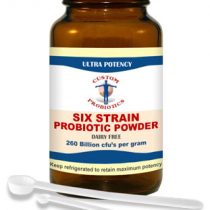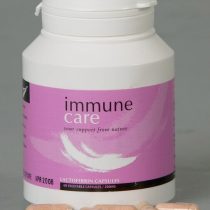Diverticular Disease

Many people have small pouches in their colon that bulge outward through weak spots, like an inner tube that pokes through weak places in a tyre. Each pouch is called a diverticulum; pouches (plural) are called diverticula. The condition of having diverticula is called diverticulosis. The condition becomes more common as people age. About half of all people over the age of 60 have diverticulosis, and of these, around 90% are asymptomatic.
When the pouches become infected or inflamed, the condition is called diverticulitis. This happens in 10 to 25 percent of people with diverticulosis. Diverticulosis and diverticulitis are also called diverticular disease, but a more accurate term is ‘colonic diverticulosis’. Initial treatment of diverticulitis is by administration of antibiotics such as metronidazole or ciprofloxacin.
Although not proven, the dominant theory is that a low-fibre diet is the main cause of diverticular disease. The disease was first noticed in the United States in the early 1900s. At about the same time, processed foods were introduced into the American diet. Many processed foods contain refined, low-fibre flour. Unlike whole-wheat flour, refined flour has no wheat bran.
Diverticular disease is common in developed or industrialised countries—particularly the United States, England, and Australia—where low-fibre diets are common. The disease is rare in countries of Asia and Africa, where people eat high-fibre vegetable diets.
Constipation makes the muscles strain to move stool that is too hard. It is the main cause of increased pressure in the colon. This excess pressure might cause the weak spots in the colon to bulge out and become diverticula. Where there is no inflammation present, but the patient suffers from constipation, an increase in fibre, use of peppermint capsules, and an osmotic laxative such as Ox-C-Bio may be useful.
Diverticulitis occurs when diverticula become infected or inflamed. Doctors are not certain what causes the infection. It may begin when stool or bacteria are caught in the diverticula. An attack of diverticulitis can develop suddenly and without warning.
Most people with diverticulosis do not have any discomfort or symptoms. However, symptoms may include mild cramps, bloating, and constipation. Other diseases such as irritable bowel syndrome (IBS) and stomach ulcers cause similar problems, so these symptoms do not always mean a person has diverticulosis. You should visit your doctor if you have these troubling symptoms.
Diverticulitis
The most common symptom of diverticulitis is abdominal pain. The most common sign is tenderness around the left side of the lower abdomen. If infection is the cause, fever, nausea, vomiting, chills, cramping, and constipation may occur as well. The severity of symptoms depends on the extent of the infection and complications.
Diverticulitis can lead to bleeding, infections, perforations or tears, or blockages. These complications always require treatment to prevent them from progressing and causing serious illness.
Bleeding
Bleeding from diverticula is a rare complication. When diverticula bleed, blood may appear in the toilet or in your stool. Bleeding can be severe, but it may stop by itself and not require treatment. Doctors believe bleeding diverticula are caused by a small blood vessel in a diverticulum that weakens and finally bursts. If you have bleeding from the rectum, you should always see your doctor.
Showing all 5 results
-

Custom Probiotics 11 Strain Probiotic Powder 100g
£165.00 Add to cart -

Custom Probiotics 6 Strain Probiotic Powder
£144.50 Add to cart -

Ecological Formulas Lactoferrin (Halo Lactoferrin) 60 caps
£69.95 Read more -

Immunecare Lactoferrin (Apo Lactoferrin) 90 caps
Sale! Original price was: £89.95.£69.95Current price is: £69.95. Read more -

Lactoferrin Xtra
£39.95 Read more
Showing all 5 results